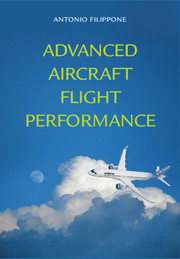Book contents
- Frontmatter
- Contents
- Tables
- Preface
- Nomenclature
- Technology Warning
- 1 Prolegomena
- 2 Aircraft Models
- 3 Weight and Balance Performance
- 4 Aerodynamic Performance
- 5 Engine Performance
- 6 Propeller Performance
- 7 Airplane Trim
- 8 Flight Envelopes
- 9 Take-Off and Field Performance
- 10 Climb Performance
- 11 Descent and Landing Performance
- 12 Cruise Performance
- 13 Manoeuvre Performance
- 14 Thermo-Structural Performance
- 15 Mission Analysis
- 16 Aircraft Noise: Noise Sources
- 17 Aircraft Noise: Propagation
- 18 Aircraft Noise: Flight Trajectories
- 19 Environmental Performance
- 20 Epilogue
- Appendix A Gulfstream G-550
- Appendix B Certified Aircraft Noise Data
- Appendix C Options for the FLIGHT Program
- Index
- References
19 - Environmental Performance
Published online by Cambridge University Press: 05 January 2013
- Frontmatter
- Contents
- Tables
- Preface
- Nomenclature
- Technology Warning
- 1 Prolegomena
- 2 Aircraft Models
- 3 Weight and Balance Performance
- 4 Aerodynamic Performance
- 5 Engine Performance
- 6 Propeller Performance
- 7 Airplane Trim
- 8 Flight Envelopes
- 9 Take-Off and Field Performance
- 10 Climb Performance
- 11 Descent and Landing Performance
- 12 Cruise Performance
- 13 Manoeuvre Performance
- 14 Thermo-Structural Performance
- 15 Mission Analysis
- 16 Aircraft Noise: Noise Sources
- 17 Aircraft Noise: Propagation
- 18 Aircraft Noise: Flight Trajectories
- 19 Environmental Performance
- 20 Epilogue
- Appendix A Gulfstream G-550
- Appendix B Certified Aircraft Noise Data
- Appendix C Options for the FLIGHT Program
- Index
- References
Summary
Overview
The previous chapters have shown several aspects of environmental performance, including aircraft noise and carbon emissions. This chapter elaborates further on the impact of aviation. We discuss the effects of commercial aviation on the formation of condensation trails (§ 19.1) and possible methods for mitigation, including altitude flexibility. We discuss briefly the controversial issue of radiative forcing of various forms of pollution (§ 19.2) and a method for calculating the landing and takeoff emissions (§ 19.3). We show a case study for a transport aircraft to illustrate key parametric effects on carbon-dioxide emissions (§ 19.4). We then propose an example of “perfect flight” (§ 19.5), that is, a flight that is not constrained by air traffic regulations. One of the key aspects that is due to dominate emissions (the trading scheme) is briefly reviewed in § 19.6.
This chapter does not attempt to enter the debate of environmental performance and its relationship with the climate change, as many stakeholders and interdependencies are involved. Furthermore, these deeper issues now overlap those of atmospheric physics, biochemistry and policy-making, which are beyond our context.
KEY CONCEPTS: Aircraft Contrails, Contrail Factor, Radiative Forcing, Altitude Flexibility, Carbon Emissions, LTO Emissions, Emissions Trading, Perfect Flight.
Aircraft Contrails
The blue skies! – What a rare pleasure at our latitudes. One cold afternoon, a clearing in the clouds brings crispy skies. The air traffic, which is normally invisible above the clouds, reveals the full scale of its impact, as shown in Figure 19.1.
- Type
- Chapter
- Information
- Advanced Aircraft Flight Performance , pp. 589 - 613Publisher: Cambridge University PressPrint publication year: 2012



